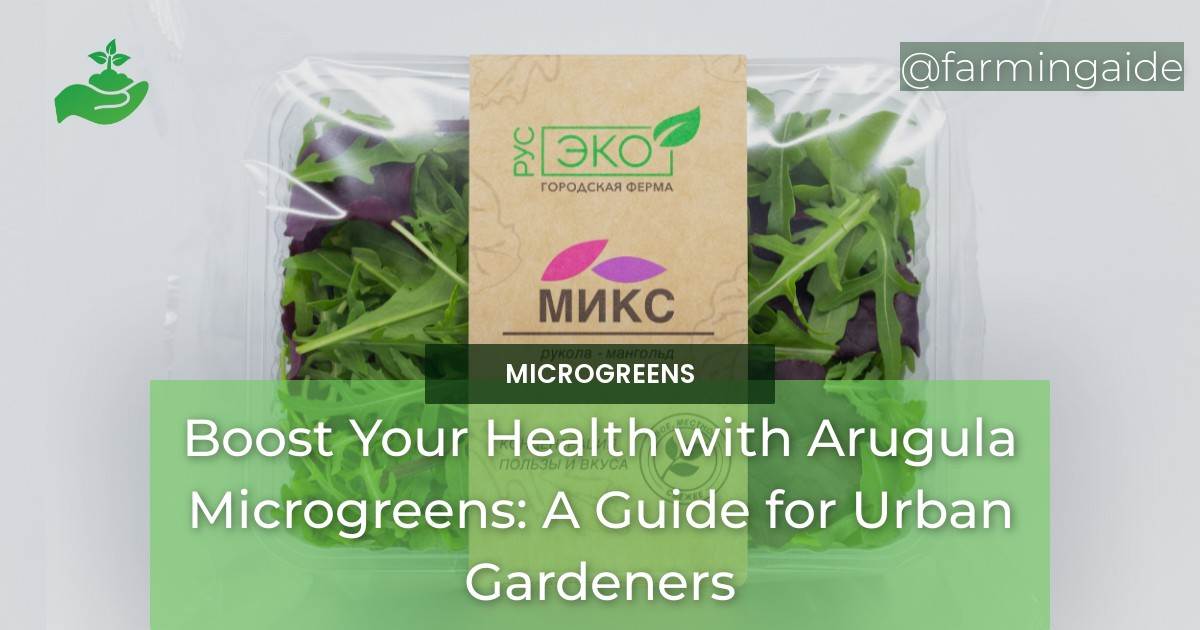Microgreens are a popular and nutritious addition to any diet, and arugula microgreens are among the best. Easy to grow and packed with essential vitamins and minerals, arugula microgreens are a must-have for any urban gardener looking to boost their health. In this guide, we’ll cover everything you need to know to grow healthy, delicious, and sustainable arugula microgreens.
Table of Contents
Health Benefits of Arugula Microgreens
Arugula microgreens are a nutritional powerhouse, packed with nutrients and antioxidants that can help improve your health in many ways. Here are some of the key benefits:
Rich in Nutrients and Antioxidants
Arugula microgreens are high in vitamins A, C, and K, as well as calcium, iron, potassium, and magnesium. They also contain antioxidants, which can help protect your cells from damage caused by free radicals.
Helps Lower Cholesterol
Studies have shown that arugula microgreens may help lower cholesterol levels. This is because they contain compounds that can help prevent the absorption of cholesterol in the intestines.
Boosts Immune System
Arugula microgreens are rich in vitamin C, which is essential for a healthy immune system. They also contain phytochemicals that can help boost immune function.
Helps to Reduce Inflammation
Arugula microgreens contain anti-inflammatory compounds that can help reduce inflammation in the body. This can help prevent chronic diseases like arthritis, heart disease, and cancer.
Ease of Growing Arugula Microgreens
One of the best things about arugula microgreens is how easy they are to grow. Here’s what you need to know:
Growing Process
The first step in growing arugula microgreens is to soak the seeds in water for a few hours. Then, spread the seeds evenly on a growing medium, such as soil or coconut coir. Cover the seeds with a thin layer of the growing medium, and mist with water.
Suitable Growing Conditions
Arugula microgreens prefer cool temperatures and indirect sunlight. They can be grown indoors or outdoors, as long as they are protected from extreme heat or cold.
Maintenance Tips
Arugula microgreens need to be watered regularly, but not overwatered. They also need to be fertilized with a balanced fertilizer once a week.
Tips for a Healthy Arugula Microgreen Plant
Here are some tips to help ensure that your arugula microgreens grow healthy and strong:
Planting Tips
- Use organic seeds to ensure the best quality and flavor.
- Plant seeds densely to ensure a thick mat of microgreens.
- Keep the growing medium moist but not waterlogged.
Watering and Fertilization
- Water arugula microgreens regularly, but be careful not to overwater.
- Fertilize once a week with a balanced fertilizer.
Pests and Diseases
Arugula microgreens are generally resistant to pests and diseases, but they can be susceptible to damping off if overwatered. To prevent damping off, make sure the growing medium is well-draining and not too wet.
Nutrient Requirements for Growing Arugula Microgreens
Arugula microgreens require specific nutrients to grow healthy and strong. Here’s what you need to know:
Soil pH and Nutrient Balance
Arugula microgreens prefer a slightly acidic soil pH between 6.0 and 6.5. They also require a balance of macronutrients (nitrogen, phosphorus, and potassium) as well as micronutrients (calcium, magnesium, and iron).
Required Nutrient Levels
Arugula microgreens require the following nutrient levels:
- Nitrogen: 50-100 ppm
- Phosphorus: 25-50 ppm
- Potassium: 100-150 ppm
- Calcium: 100-300 ppm
- Magnesium: 20-50 ppm
- Iron: 5-7 ppm
Supplemental Nutrient Options
If your soil is deficient in any of these nutrients, you can supplement with organic fertilizers or compost tea.
ALSO READ
Arugula Microgreen Growth Cycle
Arugula microgreens have a short growth cycle, typically around two weeks from seed to harvest. Here’s what you can expect:
Germination
Arugula microgreens will germinate within a few days of planting. Keep the growing medium moist and warm to encourage germination.
Growth and Development
Arugula microgreens will grow quickly and should be ready to harvest in about two weeks. Keep the growing medium moist and fertilized to encourage healthy growth.
Harvesting Timeframe
Arugula microgreens are ready to harvest when the first true leaves appear. This is typically around two weeks after planting. Use scissors to cut the microgreens just above the soil level.
Culinary Uses for Arugula Microgreens
Arugula microgreens are delicious and versatile, with a spicy and peppery flavor. Here are some ways to use them:
Flavor Profile
Arugula microgreens have a spicy and peppery flavor, with a slightly bitter aftertaste. They pair well with other greens and herbs, as well as citrus fruits and acidic dressings.
Recipe Ideas
- Add arugula microgreens to salads and sandwiches for a spicy kick.
- Use arugula microgreens as a garnish for soups and stews.
- Blend arugula microgreens into pesto for a spicy twist on a classic sauce.
Environmental Sustainability and Resource Management
Arugula microgreens are a sustainable and environmentally friendly crop, with many benefits for both the gardener and the planet.
Benefits to the Environment
- Arugula microgreens can be grown using organic farming methods, which are better for the environment and produce healthier plants.
- Arugula microgreens require less water and fertilizer than traditional crops, making them more sustainable and resource-efficient.
- Arugula microgreens can be grown using hydroponics or other soil-free methods, which reduce soil erosion and contamination.
Sustainable Growing Practices
- Practice crop rotation to prevent soil-borne diseases and pests.
- Use companion planting to attract beneficial insects and repel harmful ones.
- Use organic fertilizers and compost to improve soil fertility and reduce chemical runoff.
Conclusion
Arugula microgreens are a delicious, nutritious, and sustainable addition to any urban garden. With the right growing conditions and nutrient management, you can grow healthy and flavorful microgreens that will boost your health and contribute to a healthier planet.
RELATED ARTICLES:


